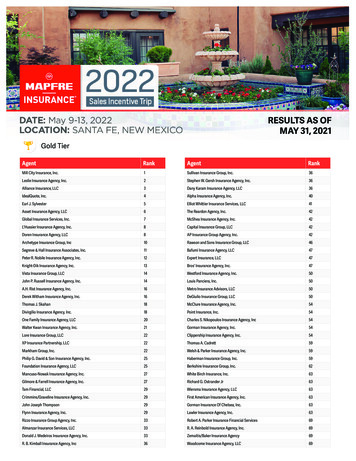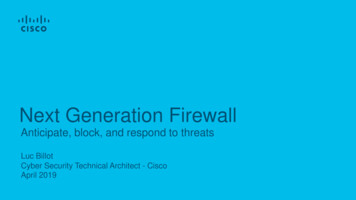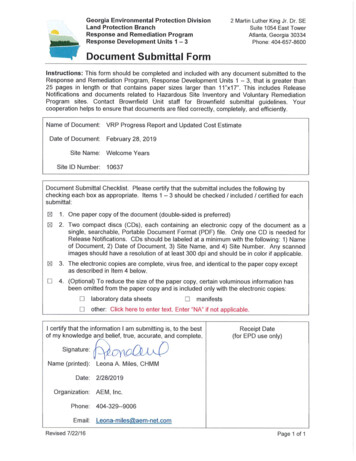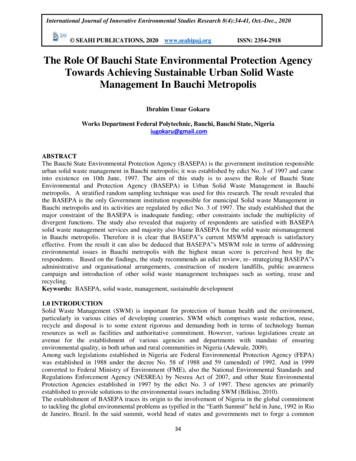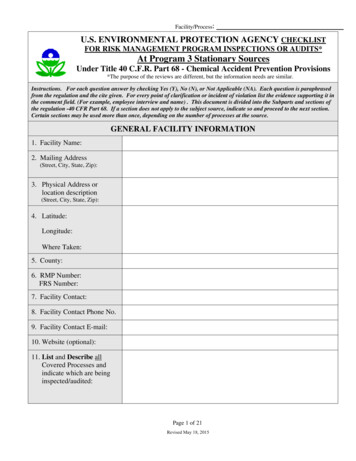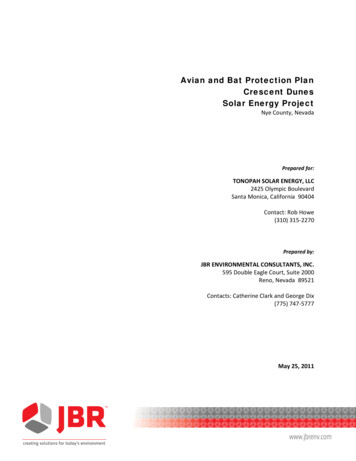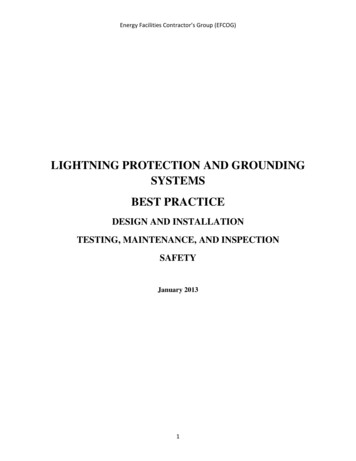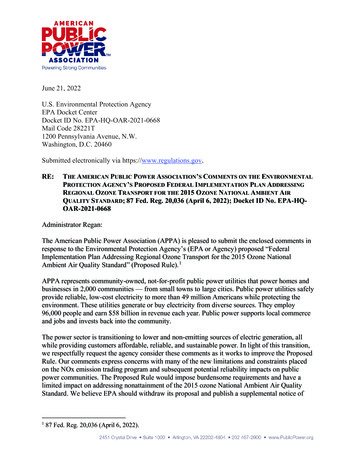
Transcription
June 21, 2022U.S. Environmental Protection AgencyEPA Docket CenterDocket ID No. EPA-HQ-OAR-2021-0668Mail Code 28221T1200 Pennsylvania Avenue, N.W.Washington, D.C. 20460Submitted electronically via https://www.regulations.gov.RE:THE AMERICAN PUBLIC POWER ASSOCIATION’S COMMENTS ON THE ENVIRONMENTALPROTECTION AGENCY’S PROPOSED FEDERAL IMPLEMENTATION PLAN ADDRESSINGREGIONAL OZONE TRANSPORT FOR THE 2015 OZONE NATIONAL AMBIENT AIRQUALITY STANDARD; 87 Fed. Reg. 20,036 (April 6, 2022); Docket ID No. EPA-HQOAR-2021-0668Administrator Regan:The American Public Power Association (APPA) is pleased to submit the enclosed comments inresponse to the Environmental Protection Agency’s (EPA or Agency) proposed “FederalImplementation Plan Addressing Regional Ozone Transport for the 2015 Ozone NationalAmbient Air Quality Standard” (Proposed Rule). 1APPA represents community-owned, not-for-profit public power utilities that power homes andbusinesses in 2,000 communities — from small towns to large cities. Public power utilities safelyprovide reliable, low-cost electricity to more than 49 million Americans while protecting theenvironment. These utilities generate or buy electricity from diverse sources. They employ96,000 people and earn 58 billion in revenue each year. Public power supports local commerceand jobs and invests back into the community.The power sector is transitioning to lower and non-emitting sources of electric generation, allwhile providing customers affordable, reliable, and sustainable power. In light of this transition,we respectfully request the agency consider these comments as it works to improve the ProposedRule. Our comments express concerns with many of the new limitations and constraints placedon the NOx emission trading program and subsequent potential reliability impacts on publicpower communities. The Proposed Rule would impose burdensome requirements and have alimited impact on addressing nonattainment of the 2015 ozone National Ambient Air QualityStandard. We believe EPA should withdraw its proposal and publish a supplemental notice of187 Fed. Reg. 20,036 (April 6, 2022).
proposed rulemaking, eliminating the proposed changes and correcting many of the errors andassumptions underlining the Proposed Rule.APPA supports comments on the Proposed Rule submitted by its members and the Large PublicPower Council and incorporates LPPC’s comments by reference. 2APPA welcomes the opportunity to work with the agency to improve the Proposed Rule. Shouldyou have questions regarding these comments, please contact Carolyn Slaughter via email(CSlaughter@PublicPower.org) or by telephone at (202) 467-2900.Sincerely,Carolyn SlaughterEnvironmental Policy DirectorAmerican Public Power AssociationComments of the Large Public Power Council on EPA’s Federal Implementation Plan AddressingRegional Ozone Transport for the 2015 Ozone National Ambient Air Quality Standards, EPA-HQ-OAR2021-0668.2www.PublicPower.org #PublicPower2
COMMENTS OF THE AMERICAN PUBLIC POWER ASSOCIATIONon theFEDERAL IMPLEMENTATION PLAN ADDRESSING REGIONAL OZONETRANSPORT FOR THE 2015 OZONE NATIONAL AMBIENT AIR QUALITYSTANDARD; PROPOSED RULE87 Fed. Reg. 20,036 (April 6, 2022); Docket ID No. EPA-HQ-OAR-2021-0668June 21, 2022Submitted by Carolyn SlaughterDirector of Environmental PolicyAmerican Public Power Association2451 Crystal Drive, Suite 1000Arlington, VA 22202202-467-2900
EPA-HQ-OAR-2021-0668I.Table of ContentsIntroduction . 4II.III.The Proposed Dynamic Budgets and Enhancements Exceed EPA’s Authority Under theGood Neighbor Provision and Should Not Be Included in the Final Rule . 5IV.If EPA Had Authority to Change State Emission Budgets, it Could Not Do So WithoutConducting Notice-and-Comment Rulemaking. . 9V. If EPA Had Authority to Require Dynamic Budget Adjustments and other Program“Enhancements,” That Authority Could Not be Exercised without Evaluation of Overcontrol inNew Rulemakings. . 10VI.EPA’s Decision to Rely on its Standard Modeling to Determine Ozone Linkages andAssess Overcontrol at Receptor Sites Close to Large Water Bodies was Arbitrary and Capricious.11VII. EPA Should Maximize Compliance Flexibility for States Entering the Revised Group 3Trading Program. . 16VIII. Key EPA Judgments and Policy Decisions Underlying the Proposed Rule areInappropriate and Unjustified. . 21A. EPA’s Assumptions Regarding the Levels of NOx Emission Reductions that Can BeAchieved Through Control Technology, and the Costs of Those Projected EmissionReductions, are Flawed. . 231.Combustion Control Technology. 232.Post-Combustion Control Technology . 24B.EPA Underestimates the Time Required to Install NOx Control Technology . 251.Combustion Control Technology. 252.Post-Combustion Control Technology . 26C. EPA Vastly Underestimated the Cost Per Ton of NOx Emission Reductions in theProposed Rule. . 27D. Even if Establishment of a Backstop Daily NOx Emission Rate 0.14 lbs/mmBtu wereLawful, Compliance with a Daily Emission Rate Limit at that Level Would Not be Feasiblefor Most EGUs. . 29E. The Generation Shifting Component of EPA’s Budget-Setting Methodology Does NotReflect Real-World Conditions and Should be Eliminated. . 30F. An Analysis of EPA Assumptions and the Resulting State Budgets and AllowanceAllocations for Nine States Demonstrates Profound Errors in EPA’s Modeling andAssumptions. 31IX.Promulgation of a Final Rule that Imposes State Budgets At or Near the Levels Presentedin the Proposed Rule May Result in Electric Reliability Impacts. . 33X.Conclusion . 382
EPA-HQ-OAR-2021-0668COMMENTS OF THE AMERICAN PUBLIC POWER ASSOCIATIONon theFEDERAL IMPLEMENTATION PLAN ADDRESSING REGIONAL OZONETRANSPORT FOR THE 2015 OZONE NATIONAL AMBIENT AIR QUALITYSTANDARD;PROPOSED RULE87 Fed. Reg. 20,036 (April 6, 2022); Docket ID No. EPA-HQ-OAR-2021-0668June 21, 2022On April 6, 2022, the U.S. Environmental Protection Agency (EPA or the Agency)published its “Federal Implementation Plan Addressing Regional Ozone Transport for the 2015Ozone National Ambient Air Quality Standard; Proposed Rule” (the Proposed Rule). 1 TheAmerican Public Power Association (APPA or the Association) appreciates the opportunity tosubmit the following comments on the Proposed Rule. APPA is the voice of not-for-profit,community-owned utilities that power 2,000 towns and cities nationwide. We represent publicpower before the federal government to protect the interests of the more than 49 million peoplethat public power utilities serve, and the 96,000 people they employ. Our association advocatesand advises on electricity policy, technology, trends, training, and operations. Our membersstrengthen their communities by providing superior service, engaging citizens, and instillingpride in community-owned power. APPA participates on behalf of its members collectively inEPA’s rulemakings and other Clean Air Act (CAA or the Act) proceedings that affect theinterests of public power utilities. APPA therefore has a clear interest in the present rulemaking.For the reasons discussed below, the Proposed Rule is flawed, unlawful, and should not bepromulgated. To the extent EPA moves forward with its proposal we offer the followingrecommendations to improve implementation:187 Fed. Reg. 20,036 (Apr. 6, 2022).3
EPA-HQ-OAR-2021-0668 EPA should undertake full notice-and-comment rulemaking if the agency adjustsstate emission budgets from year to year. Where state emission budgets are subject to year over year change EPA shouldconduct an overcontrol analysis in those years. EPA should correct its air quality modeling in urban costal areas to account forthe unique characteristics of ozone formation in those areas, which is frequentlyVOC limited. EPA must also conduct a new overcontrol analysis of these costalareas using corrected modeling. EPA should increase compliance flexibility in the Groups 2 and 3 tradingprograms. EPA should update its Reference Case analysis, NOx control technologymodeling, cost projections and equipment installation timelines which unpin theProposed Rule. The technical report submitted along with these comments outlinethe necessary corrections to be addressed in a revised technical analysis thatshould accompany a supplemental proposal.II.IntroductionIn the Proposed Rule, EPA claims to “adhere[] closely” to the four-step Cross-State AirPollution Rule (CSAPR) framework that it has used in recent interstate transport rules to addressinterstate transport for the 2015 ozone national ambient air quality standard (NAAQS), with afew changes to reflect “lessons learned from the performance of regulatory programs establishedby previous interstate transport rulemakings” and to incorporate “recent information on the4
EPA-HQ-OAR-2021-0668nature of ozone transport and emissions reductions opportunities.” 2 This is a vast understatementof the magnitude of the Proposed Rule’s deviations from EPA’s CSAPR framework. EPA’sproposed changes to the EGU trading program – including “dynamic budgets” and otherproposed “enhancements” – exceed EPA’s authority under CAA section 110(a)(2)(D)(i)(I). Forthe reasons explained below, EPA should modify the proposal to recognize that compliance withthe state budgets promulgated by EPA in federal implementation plans (FIPs) implementing theGood Neighbor mandate set out in section 110(a)(2)(D)(i)(I) of the Act eliminate emissions thatsignificantly contribute to nonattainment or interfere with maintenance. EPA should withdrawthe Proposed Rule and should publish a supplemental notice of proposed rulemaking eliminatingthese changes and correcting the many errors and poor assumptions on which the Proposed Ruleis based if it plans to issue FIPs.III.The Proposed Dynamic Budgets and Enhancements Exceed EPA’s Authority Underthe Good Neighbor Provision and Should Not Be Included in the Final RuleSection 110(a)(2)(D)(i)(I) of the Act – the “Good Neighbor Provision” – requires statesto submit implementation plans (SIPs) that “contain adequate provisions prohibiting anysource or other type of emissions activity within the State from emitting any air pollutant inamounts which will contribute significantly to nonattainment in, or interfere withmaintenance by, any other State with respect to any NAAQS.” 3 If a state fails to amend its SIPto prohibit such emissions, EPA is required to propose and promulgate a FIP curing thatdeficiency.In EPA v. EME Homer City Generation, L.P., 572 U.S. 489 (2014), the Supreme Courtreviewed EPA’s interpretation of the Good Neighbor Provision in the original CSAPR and2387 Fed. Reg. at 20,041.42 U.S.C. § 7410(a)(2)(D)(i)(I).5
EPA-HQ-OAR-2021-0668affirmed “EPA’s understanding of which upwind emissions were within the Good NeighborProvision’s ambit.” 4 To be within that “ambit,” the Court explained, upwind emissions mustboth (1) contribute “one percent or more of a NAAQS in [a] downwind state,” and (2) be able to“be eliminated cost effectively.” 5 States were obligated “to eliminate only emissions meetingboth of these criteria.” 6 To prohibit emissions meeting both criteria, EPA imposed a “budget” foreach state defining the overall cost effective emission reduction target that must be achieved tosatisfy that state’s Good Neighbor obligations. 7 EPA describes the role of state emission budgetsin a consistent manner in the Proposed Rule. 8State emission budgets, allocated to sources within each state, create a “cap and trade”system that allows sources that reduce “emissions below the budget target to sell allowances tosources that could not reduce emissions as cheaply.” 9 As a result, some units will overcontrol,and others will under control. If control performance of one unit deteriorates over time, theexcess emissions from that unit can be offset by reductions at other units in the program. EPAhas long touted the compliance flexibility the market-based CSAPR framework allows. 10EME Homer City, 572 U.S. 502.Id. at 502-03. Using its CSAPR framework, EPA “calculate[s], for each upwind State, the quantity ofemissions the State could eliminate at each of several [cost-per-ton] thresholds”, id. at 501, “then identifie[s]significant cost thresholds, points in its model where a noticeable change occurred in downwind air quality, such aswhere large upwind emission reductions become available because a certain type of emissions control strategybecomes cost-effective,” and ultimately “translate[s] the cost thresholds . . . selected into amounts of emissionsupwind States would be required to eliminate.” Id. at 501-502 (internal quotations omitted).6Id. at 503 (emphasis added).7See e.g., 82 Fed. Reg. 23,054, 23,065 (Apr. 30, 2021) (Final Revised CSAPR Update) (explaining thestate emission budgets promulgated in that rule “represented emissions remaining in each state after elimination ofthe amounts of emissions that EPA identified would significantly contribute to nonattainment or interfere withmaintenance of the 2008 ozone NAAQS in downwind states”).8See 87 Fed. Reg. at 20,106 (“an ‘emissions budget’ is established for each state for each control period,representing EPA’s quantification of the emissions that would remain under certain projected conditions”).45EME Homer City, 572 U.S. at 503.See, e.g., 76 Fed. Reg. 48,208, 48,210-48,211 (Aug. 8, 2011) (Original CSAPR) (“The Transport Rule’sair quality-assured trading approach will assure environmental results in each state while providing market-basedflexibility to covered sources through interstate trading”); 87 Fed. Reg. at 20,105 (“The [electric utility] sector’s9106
EPA-HQ-OAR-2021-0668EPA’s Proposed Rule, however, layers “command and control” mandates upon “market-driven”reductions in order to achieve greater, and more costly, reductions than the Good Neighborprovision authorizes. In the Proposed Rule, EPA finds that “as long as the [certain] NOxemissions reduction controls [identified in the Proposed Rule] are available and can beimplemented (such as optimization of [selective catalytic reduction (SCRs)]), they must beimplemented, even as total NOx emissions reductions on a mass basis decline.” 11 EPA’sproposals to establish more stringent emission budgets through its dynamic budgeting concept,as well as “command and control” program enhancements implement this finding.EPA proposes to require “dynamic state emissions budgets” for future control periodsbeginning with the ozone season in 2025. 12 This will result in reduced budgets, prohibitingpreviously budgeted emissions, which reflect emissions remaining after application of costeffective emission reductions. 13 EPA also proposes a suite of “enhancements” to the Group 3trading program, including an annual “recalibration” of the Group 3 allowance bank, to removewhat EPA considers to be “surplus allowances” that “diminish[] the intended stringency [ofthe program].” 14 EPA characterizes this recalibration as a new “design element,” similar to thedynamic emission budgets, that changes the structure of the CSAPR trading program as a whole,unusual flexibility with respect to how emissions reductions can be achieved makes the flexibility of a tradingprogram particularly useful as a means of lowering the overall costs of obtaining such reductions”).1187 Fed. Reg. at 20,095.12Under this proposal, state emission budgets would be adjusted for each control period beginning withozone season 2025 by applying the required control stringency to updated heat input data measured in the year twoyears before the control period for which the budget would apply (i.e., EPA would use heat input data from 2023 toestablish 2025 state emission budgets).13Further, this dynamic budgeting approach could result in regional allowance shortfalls if a relatively highyear of generation (i.e., heat input) allowance budget was based on a low year of generation for the prior year usedto determine budget allowances. Heat input is variable year over year due to many factors such as extreme weather,outage duration, grid changes and general changes in the dispatch order. Generation owners with larger fleets wouldhave more flexibility to trade compared to owners with a few or only one unit, which is representative of publicpower utilities.1487 Fed. Reg. at 20,109.7
EPA-HQ-OAR-2021-0668and is intended “to maintain the rule’s selected control stringency and related EGU effectiveemissions rate performance level as the EGU fleet evolves over time.” 15 Additionally, EPAproposes to impose unit-level enhancements intended to “improve emissions performance atindividual units.” 16 These unit-level enhancements include imposition of a backstop daily NOxemission rate of 0.14 lb/mmBtu on most large coal-fired EGUs, 17 and unit-specific secondaryemission limitations that would apply in circumstances where an EGU is deemed to havecontributed to an exceedance of a state’s assurance level. 18By reducing state budgets and imposing program-level and unit-specific “enhancements,”the proposal mandates “command and control” reductions in addition to those the affected unitshave achieved to comply with the “market based” budget program. In other words, they requirereductions below budgeted emissions that are not prohibited under the Good Neighborprovision. 19 These budgeted emissions are the emissions that remain after elimination of thoseemissions that can be eliminated through cost effective emission reductions. As the SupremeId. at 20,107.Id. at 20,109.17This daily NOx emission rate – which is based on a daily emission rate projected to reflect continuousoperation of SCR, id. at 20,111 – would apply to coal-fired steam units greater than or equal to 100 MW beginningin 2024 for units with existing SCRs, and to units currently without SCR beginning in 2027. Id. at 20,110.1516Specifically, unit-specific secondary emission limitations would apply in circumstances where (i) “astate’s assurance level for a control period has been exceeded,” (ii) “the unit is included in a group of units to whichresponsibility for the exceedance has been apportioned under the program’s assurance provisions,” and (iii) “the unitoperated during at least 10% of the hours in the control period.” Id. at 20,112. EPA explains that, “[w]here theseconditions are met, the unit’s secondary emissions limitation would consist of a prohibition on NOx emissionsduring the control period that exceed by more than 50 tons the NOx emissions that would have resulted if the unithad achieved an average emissions rate for the control period equal to the higher of 0.10 lb/mmBtu or 125 percent ofthe unit’s lowest average emissions rate for any previous control period under any CSAPR seasonal NOx tradingprogram during which the unit operated for at least 10 percent of the hours” and “would be in addition to, not in lieuof, the primary emissions limitation applicable to each source.” Id. EPA also states that “any emissions by a unitexceeding its secondary emissions limitation w[ill] be subject to potential administrative or judicial action andsubject to penalties and other forms of relief under the CAA’s enforcement authorities.” Id.18See, e.g., id. at 20,039 (noting that the “additional features” EPA proposes to include in the revisedGroup 3 trading program, including dynamic adjustments to emission budgets and enhancements, are intended to“help maintain control stringency over time and improve emissions performance at individual units, providingfurther assurance that existing pollution controls will be operated during the ozone season”).198
EPA-HQ-OAR-2021-0668Court has emphasized, EPA may only require states to reduce emissions that contribute “onepercent or more of a NAAQS in [a] downwind state,” and can “be eliminated cost effectively.” 20EPA lacks authority under the Good Neighbor Provision to demand reductions to “improve [anindividual unit’s] emissions performance” 21 when market driven reductions at other units, or aunit’s current emission performance, assures compliance with a state’s budget. EPA may onlycontrol upwind-state sources to eliminate the “amount[]” of emissions that “contributesignificantly to nonattainment in, or interfere with maintenance by,” downwind states, quantifiedin each state’s emission budget. 22IV.If EPA Had Authority to Change State Emission Budgets, it Could Not Do SoWithout Conducting Notice-and-Comment Rulemaking.Even if EPA had authority to adjust states’ “Good Neighbor” budgets from year to year,section 307(d) of the Act would require EPA to undertake full notice-and-comment rulemakingin order to do so. CAA § 307(d)(1)(B) (subsection 307(d) “applies to . . . the promulgation oralteration of an implementation plan by the Administrator under section 7410(c) of this title”).In the Proposed Rule, EPA describes a procedure through which it would issue new stateemission budgets each year by “ministerial action.” 23 As explained previously, state emissionbudgets are – and have been since the inception of the CSAPR program – the control measureunder CAA section 110(a)(2)(A) used to define the amount of emissions that the Good NeighborEME Homer City, 572 U.S. at 502-503.87 Fed. Reg. at 20,109.2242 U.S.C. § 7410(a)(2)(D)(i)(I). The Good Neighbor Provision does not authorize EPA to impose“enhancements” that go beyond the state budgets. APPA agrees however, that if EPA nonetheless imposes abackstop daily NOx emission rate in a final rule, that rate should not apply to EGUs that commit to retiring by theend of 2028. See 87 Fed. Reg, at 20,122. It would not be cost effective for units with planned retirements withinthis short timeframe to install emission controls or take other similar steps to reduce emissions.2021See 87 Fed. Reg. at 20,117 (describing EPA’s plan to issue a notice of data availability by March 1 ofeach year beginning in 2024, announcing the state budget for the following ozone season).239
EPA-HQ-OAR-2021-0668provision prohibits. Thus, if EPA had authority to change the stringency of state budgets, it couldonly do so following a section 307(d) FIP rulemaking.V.If EPA Had Authority to Require Dynamic Budget Adjustments and other Program“Enhancements,” That Authority Could Not be Exercised without Evaluation ofOvercontrol in New Rulemakings.Setting aside whether EPA has the authority to impose dynamic adjustment to emissionbudgets and other program “enhancements” under the Good Neighbor provision as a generalmatter, the effect of these program changes is likely to result in overcontrol, which the SupremeCourt and the D.C. Circuit have explained is prohibited. 24EPA describes its overcontrol analysis in the Proposed Rule, 87 Fed. Reg. at 20,098-99,but does not announce plans to re-evaluate overcontrol in future years, as the budgets arereduced. Instead, EPA asserts without explanation or support that “retention of a constant degreeof [control] stringency over time in emissions budgets under a flexible trading program wouldnot constitute overcontrol any more than the permanent imposition of emissions rate standardson individual sources at the time of the rulemaking would constitute overcontrol.” 25 Thisunsupported statement ignores the Supreme Court’s instruction to ensure that it does not requireemission reductions from a state that exceed “the amount necessary to achieve attainment inevery downwind State to which it is linked.” 26 Whenever EPA changes the “amount” ofemission reductions required of a state, it must also check for overcontrol. Conducting a singleovercontrol analysis when a rule is promulgated, as EPA did in past CSAPR rulemakings thatimposed static state emission budgets, is not sufficient to prevent overcontrol under24See EME Homer City v. EPA, 795 F.3d 118, 126 (D.C. Cir. 2015) (noting “[t]he Supreme Court agreedwith the Court of Appeals to this extent: The Transport Rule violates the statute when it requires an upwind State toreduce emissions by more than the amount necessary to achieve attainment in every downwind State to which it islinked” (quoting EME Homer City, 572 U.S. at 521) (internal quotations and emphasis omitted).2587 Fed. Reg. at 20,095.26572 U.S. at 521.10
EPA-HQ-OAR-2021-0668circumstances where state emission budgets are subject to change from year to year, and dailyNOx emission rate limits and unit-level secondary emission limits are in effect indefinitely.VI.EPA’s Decision to Rely on its Standard Modeling to Determine Ozone Linkages andAssess Overcontrol at Receptor Sites Close to Large Water Bodies was Arbitraryand Capricious.In the preamble to the Proposed Rule, EPA asserts that “the vast majority of thedownwind air quality areas are NOx-limited, rather than [volatile organic compound (VOC)]limited,” and “[t]herefore, the proposed rule’s strategy for reducing regional-scale transport ofozone targets NOx emissions from stationary sources to achieve the most effective reductions ofozone transport over the geography of the affected downwind areas.” 27 This conclusion ignoresthe results of recent studies of ozone formation in urban areas along large water bodies, includingLake Michigan and Long Island Sound, and the results of EPA’s own model performanceevaluation.EPA participated in the 2017 Lake Michigan Ozone Study (LMOS), a collaborativemultiagency field study led by the Lake Area Director’s Consortium (LADCO) and its memberstates, together with the National Aeronautics and Space Administration, the National Oceanicand Atmospheric Administration, as well as a number of research groups from universities andother institutions. 28 The results of the LMOS demonstrate that ozone formation occursdifferently in urban-influenced coastal areas and is frequently VOC-limited, rather than NOx87 Fed. Reg. at 20,053.See, e.g., MOS2017/LMOS LADCO report revision apr2019 v8.pdf (Preliminary FindingReport, initial release July 19, 2018, revised release Apr. 22, 2019); https://www-air.larc.nasa.gov/missions/lmos/.As explained in a recent article on the LMOS, “[u]rban-influenced coastal environments are an air qualitymanagement challenge because of complex wind patterns, shallow stable marine boundary layers, and theinteraction of these meteorological features with ozone precursor (reactive nitrogen and volatile organic compound,VOC) emissions,” and as a result, “[m]any of the counties in the eastern [United States] where ozone concentrationsexceed the 2015 ozone [NAAQS] of 70 ppb are along coastlines.” C. Stanier et al., Overview of the Lake MichiganOzone Study 2017, BULLETIN OF THE AMERICAN METEOROLOGICAL SOCIETY (Nov. 2021) (hereinafter, “C.Stanier”).272811
EPA-HQ-OAR-2021-0668limited. 29 EPA’s Office of Research of Development and EPA Region 1 were also supporters ofthe Long Island Sound Tropospheric Ozone Study (LISTOS), which evaluated ozone formationand transport along Long Island Sound and observed similar phenomena, 30 and EPA has recentlyexpressed interest in conducting additional research on ozone in areas of coastal Connecticut as afollow-up to LISTOS. 31 This research shows that EPA’s standard modeling does not accuratelymeasure ozone concentrations in coastal areas or the contributions from upwind states to ozoneconcentrations in those areas. In particular, results of the LMOS showed “both the NAMCMAQ 12-km modeling and the higher resolution (4-km) WRF-Chem modeling” – both ofwhich EPA used in modeling for the Proposed Rule – “underestimate peak ozone concentrationsand overestimate NO2 concentrations during ozone episodes.” 32 Differences in ozone formationand transport in coastal areas are due in large part to the influence of sea breeze, or in the case ofcoastal areas around Lake Michigan, lake breeze. 33 Research on inland penetration of sea breezehas indicated that areas 30 to 40 kilometers (km) inland can be influenced by sea breeze and itsTechnical aspects of the 2017 LMOS are addressed in greater detail in comments being submitted by theMidwest Ozone Group and Ameren Missouri in this rulemaking, and in comments submitted by Ameren Missouri inthe rulemaking on EPA’s proposed disapproval of Missouri’s interstate transport SIP for the 2015 ozone NAAQS.Docket ID No. EPA-R07-OAR-2021-0851-0026. Ameren Missouri’s comments on proposed SIP disapproval areincorporated by reference herein. We note that in its Air Quality Modeling Technical Support Document (TSD) forthe Proposed Rule, EPA-HQ-OAR-2021-0668-0099 (AQM TSD), EPA states that “The information i
The American Public Power Association (APPA) is pleased to submit the enclosed comments in response to the Environmental Protection Agency's (EPA or Agency) proposed "Federal Implementation Plan Addressing Regional Ozone Transport for the 2015 Ozone National Ambient Air Quality Standard" (Proposed Rule). 1
